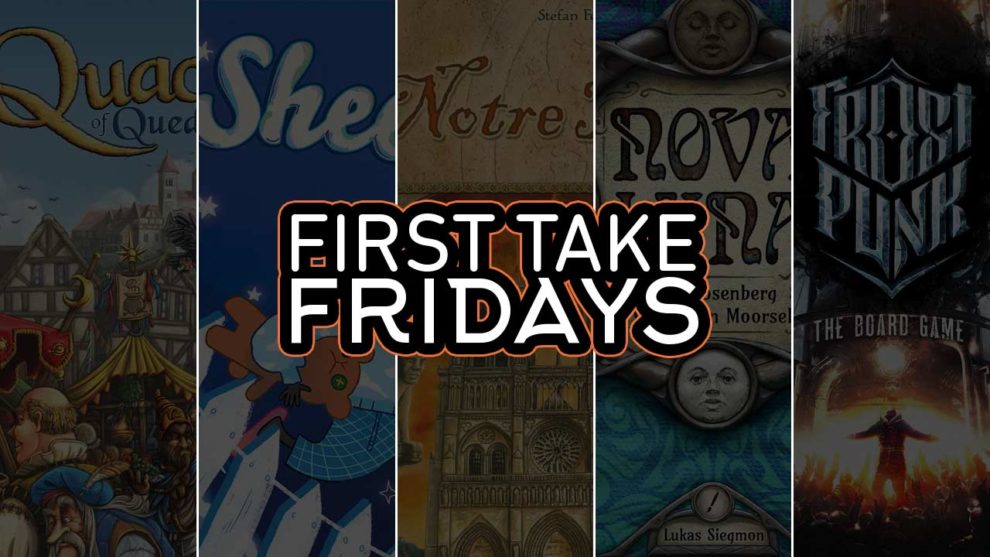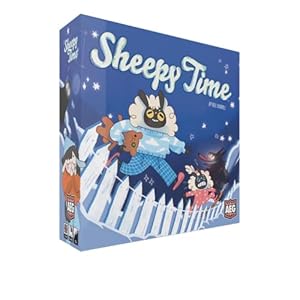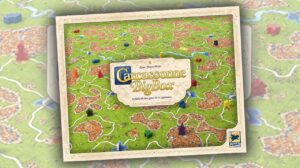Quacks of Quedlinburg – David McMillan
Quacks is a bag builder about questionable potion making. Each round of the game the players are going to be reaching into their bags of potion-making ingredients and then drawing them out, one at a time, and placing them into their cauldron. The cauldron is divided up into a numbered track and each ingredient placed determines how far along the next ingredient will be placed. The objective is to move as far along the track as you possibly can without going bust (by drawing more than a total value of 7 white ingredients). The further along you get, the more points you’ll earn and the more money you’ll have to spend on bigger, and better, ingredients. Each ingredient in the game has a unique ability that fires off whenever it’s drawn from your bag. The more non-white ingredients you have, the better your odds of being able to go for a long spell before calling it quits.
Like many people, Quacks first appeared on my radar when it won the Kennerspiel des Jahres in 2018. So, it’s embarrassing to admit that it’s taken me four years to finally play it. That being said, having played it, I don’t feel like I’ve missed much. While the game was enjoyable, it never really felt like I was in any kind of control. Whether or not I won just came down to pure, dumb luck. While I got lucky and drew the tiles I needed to move along the track, my opponents didn’t, even though the contents of our bags were largely the same. Quacks is one of those games where the rich just keep getting richer and that ultimately leaves me unexcited to play it again.
Check out our review of Quacks of Quedlinburg (and our review of the Herb Witches and Alchemists expansions!).
Ease of entry?:
★★★★★ – No sweat
Would I play it again?:
★★☆☆☆ – Would play again but would rather play something else
Read more articles from David McMillan.
Sheepy Time – Bob Pazehoski, Jr.
For most of my life, when I count sheep, I’ve imagined a long line of fluffy buddies jumping over that fence with a supreme interest in aiding my beauty rest. As it turns out, it was just one sheep running in circles. Oh, and that one sheep was being chased by a slow-walk Nightmare in a cute but horror-movie-esque kind of way. At least, that’s what Sheepy Time recently taught me.
Sheepy Time is a push-your-luck race around a 10-space track in which you—the aforementioned fluffy buddy—are attempting in each round to squeeze in as many laps as possible before the Nightmare completes a single trip around the board. Doing so with more efficiency than your opponents results in the head moving closer to the pillow and a good night’s rest for your client, presumably a younger version of, well, me. This game is rock solid mechanically and a load of fun for the family. There are just enough quirks in the (many) Dream tile powers and the (not many—this one screams for an expansion pack) Nightmares to make this one worth its weight in downy feathered goodness.
Ease of entry?:
★★★★★ – No sweat
Would I play it again?:
★★★★★ – Will definitely play it again
Watch our review of Sheepy Time.
Read more articles from Bob Pazehoski, Jr.
Notre Dame – Andy Matthews
Notre Dame has been held up as a classic hobby board game from designer Stefan Feld. Set in Paris during the 14th century, players act as heads of their respective families and compete for wealth and prestige. But how does it hold up to plays in the golden age of cardboard? Pretty well, all things considered.
I’ve had a copy of Notre Dame for a year or two and finally decided that now would be the time to play it. While the production value leaves a little to be desired, with thin cardboard tokens and player boards, the design itself is quite unique. The boards are modular and allow for player counts between 3 and 5 simply by rotating each neighborhood. Each player has the same deck of cards, but because you draw 3 from your deck, then select 1 and pass to the next player you might give away a valuable card to your neighbor on the left…hopefully you receive an equally valuable card from your right. The choices each turn are simple but, as is usually the case with eurogames, deceptively deep. Notre Dame is primarily an optimization puzzle…take an action once and it rewards you with very little, but subsequent actions become more and more powerful.
While I’m glad I finally played Notre Dame, modern game design has moved on, and there are better games nowadays.
Ease of entry?:
★★★★☆ – The odd bump or two
Would I play it again?:
★★★☆☆ – Wouldn’t suggest it, but would happily play it
Read more articles from Andy Matthews.
Nova Luna – Tom Franklin
Nova Luna has players claiming tiles from a round Moon Track on their turn. These tiles are placed in their playing area adjacent to their other claimed tiles. Each tile typically has 1-3 circles in the corner with colored dots. When you’ve placed other tiles with the matching background colors adjacent to a tile with the matching dots, you place one of your discs over the matching dots. The first player to use all their discs wins.
This is a game from designer Uwe Rosenberg and features one of his recent, favorite mechanics—the person who is in the last position around the common track has the next turn. Since each tile has a number in the upper left corner signifying how many spaces along the Moon Track you need to move, selecting the right tile at the right moment gives the game some added strategy.
Largely a solitaire puzzle game, Nova Luna is another low-stress, easy-going game along the lines of Cascadia.
Ease of entry?:
★★★★☆ – The odd bump or two
Would I play it again?:
★★★★☆ – Would like to play it again
Read more articles from Tom Franklin.
Frostpunk: The Board Game – Justin Bell
I backed Frostpunk: The Board Game based on the video game of the same name. Like This War of Mine: The Board Game (also based on a survival video game), Frostpunk is a massive box with stellar production, tons of cards, a shocking number of rules, and can be described as a game more tied to surviving it than playing it.
Luckily for me, one of the guys who went all-in and backed the deluxe version of the game invited me over so that we could try the game. And now that I’ve played it twice, I can confirm that I will be selling my copy of the game on the secondary market as soon as the holidays are over, because we had such a terrible time playing.
Our first game ended after just two rounds with a loss. One guy was sure we had done something wrong, so we played it again…and lost after just three rounds. Frostpunk is such a grind; just a few hours after playing, I’m struggling to remember if I made any meaningful choices during play. Eight of the nine steps in each round involve essentially no choices, because they require revealing random event cards, worker upkeep, hunger tracking, updating the weather tracker, etc. Frostpunk is mostly a chance to remind players that they should be punished simply for sitting down at the table. A joyless experience, Frostpunk left me stunned; I waited 14 extra months past its delivery date to get punched directly in the face.
Ease of entry?:
★☆☆☆☆ – Rough
Would I play it again?:
☆☆☆☆☆ – No chance
















Add Comment